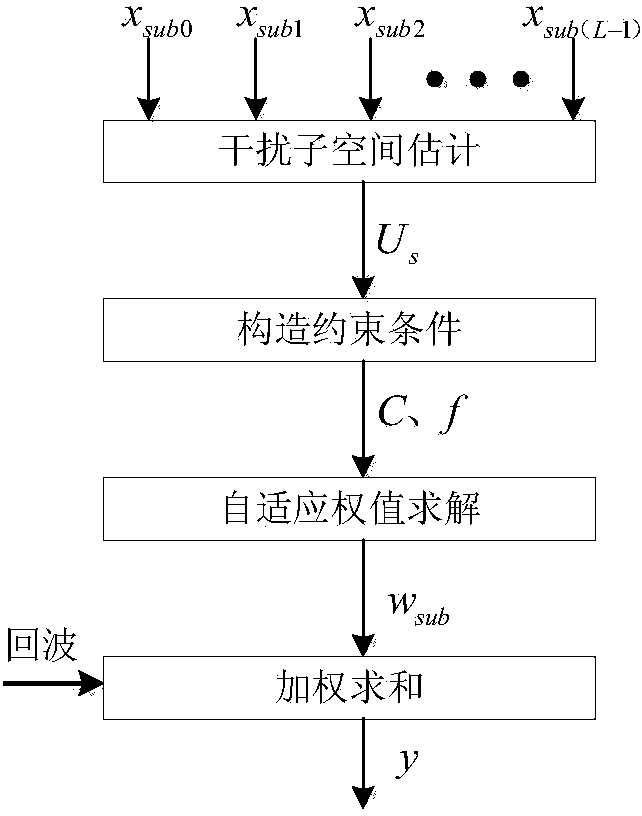Submatrix level linear constraint self-adaptive beam forming method based on feature subspaces
An adaptive beam and characteristic subspace technology, applied in radio wave measurement systems, instruments, etc., can solve problems such as signal processing influence, weight vector not satisfying constraint conditions, and side lobe elevation
- Summary
- Abstract
- Description
- Claims
- Application Information
AI Technical Summary
Problems solved by technology
Method used
Image
Examples
Embodiment 1
[0045] Based on the above basic scheme, the method for calculating the subarray-level covariance matrix of the receiving array in step 1 is:
[0046] First establish the signal model: for a linear array with N array elements, d n is the distance between the n-th array element of the linear array and the reference point, where n takes all positive integers between 0 and N-1, and the reference point is the arbitrarily selected i-th array element, usually the 0th array element Yuan is the reference point, at this time d 0 =0; For a linear array, when there are P mutually uncorrelated interference signals, the receiving array is X(t)=AS(t)+N(t), where L≥P.
[0047] where A=[a(θ P ),…a(θ 1 )], S(t)=[s 1 (t),...,s P (t)] T , a(θ P )~a(θ 1 ) is in turn a linear array relative to P interfering signal steering vectors, where θ p is the incident direction of the pth interference signal, and the value of p is between 1 and P; a ( ...
Embodiment 2
[0052] In this embodiment, on the basis of the above-mentioned embodiment 1, assuming that the direction of the desired signal is consistent with the beam direction of the array antenna, the method of calculating the subarray-level covariance matrix in step 1 is: according to the side lobe level of the receiving array pattern, The phase shift value and the sub-array transfer matrix are obtained, and the sub-array level covariance matrix is obtained according to the sub-transfer matrix and the covariance matrix of the receiving array.
[0053] Wherein the sub-array transfer matrix is specifically: T=W win ΦT 0 , where W win is the diagonal matrix of weighting coefficients, W win =diag(w n ) n=0,1,… , N-1 , diag(·) is a diagonal matrix formed by ·, where w n is the weighting coefficient of the nth array element, determined according to the side lobe level of the receiving array pattern, where n takes all integers between 0 and N-1; Φ is a diagonal array of phase shift ...
Embodiment 3
[0060] After step 1, the estimated interference subspace is obtained. In order to obtain the adaptive weight vector, it is necessary to construct a constraint matrix and a constraint response vector, so that the algorithm can adaptively suppress the interference signal and keep the beam pointing at θ 0 The gain of is a constant, the sub-array-level constraint matrix constructed in step 2 of this embodiment is C, and the corresponding vector of sub-array-level constraints is f:
[0061] C=[a sub (θ 0 ), U s ]=[a sub (θ 0 ),e 1 ,e 2 ,...,e P ]; f = [μ,0,0,...,0] 1×(P+1) ;
[0062] a sub (θ 0 ) is the steering vector of the desired signal at the subarray level;
[0063] μ is a constant, specifically, in the desired signal direction θ 0 The array gain at , usually takes a value of 1.
[0064] The sub-array-level constraint matrix C and the corresponding vector f of the sub-array-level constraints satisfy: w sub H C=f, where w sub is the adaptive weight vector.
[...
PUM
 Login to View More
Login to View More Abstract
Description
Claims
Application Information
 Login to View More
Login to View More - R&D
- Intellectual Property
- Life Sciences
- Materials
- Tech Scout
- Unparalleled Data Quality
- Higher Quality Content
- 60% Fewer Hallucinations
Browse by: Latest US Patents, China's latest patents, Technical Efficacy Thesaurus, Application Domain, Technology Topic, Popular Technical Reports.
© 2025 PatSnap. All rights reserved.Legal|Privacy policy|Modern Slavery Act Transparency Statement|Sitemap|About US| Contact US: help@patsnap.com



